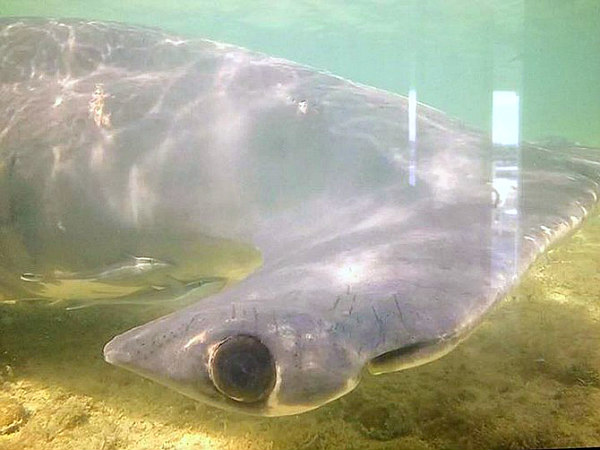
The hammerhead shark seen in the Montagu Beach area.
THERE is still no clarity on whether a large Great Hammerhead shark spotted over the weekend has been speared, harmed or even killed in an effort to drive it away from the eastern New Providence coastline.
Last night, officials of the Bahamas National Trust (BNT) spoke out against harming the creature, stressing the valuable role sharks play in protecting the fragile ecosystem of Bahamian marine life.
Videos were shared via various social media platforms on Friday and Saturday, one in particular which showed the shark - estimated to be between 14ft and 16ft - swimming near the shore at Montagu Beach and fish dock.
It showed dozens of onlookers marvelling at the presence of the shark. In another, snorkellers accompanied the shark in the water as it swam around.
According to the BNT, the Great Hammerhead is the largest of the hammerhead sharks and is found in tropical and sub-tropical waters around the world. Mature hammerheads have virtually no predators, but like most shark species, they are heavily fished, both commercially and recreationally.
The BNT noted that the Great Hammerhead should be hailed as a keeper of the conch because the species is said to be directly responsible for controlling predators - such as stingrays - that feed on the queen conch.
“Their importance to the culture and economy of the Bahamas is the reason why sharks were formally protected by the government in 2011. However, more public education on shark behaviour is clearly needed,” yesterday’s statement read.
“This was evident from the discussions that followed the recent social media posts. Many commenters were surprised that such a large shark would come so close to shore, but as most fishermen are aware, this is a regularly observed behaviour. Hammerheads prefer to eat the Southern Sting Ray which often comes into shallow water to feed and hide from predators.
“This shark is very inquisitive and was possibly drawn to the Montagu area by the intense smell of skinned conch and fish, hoping to find a few rays. Much of the social media conversation focused on the danger to swimmers. But although these sharks certainly have the ability to cause harm, they rarely even acknowledge divers in the water. People swim with Great Hammerheads and other large sharks every day in the Bahamas without incident.”
The BNT made specific note of a video making the rounds on Saturday, in which the shark could be seen swimming peacefully with snorkellers near the Nassau harbour.
The group said the mouth structure of this species is not suited for attacking a large animal like a human, as it is adapted for catching bottom dwellers like rays.
“A common reaction to such a large predator within an area frequently used by people is to spear it, either to kill it or drive it away. This is not just a local reaction, but rather an international one. Reports indicate that this may be what happened to the large visitor in Nassau Harbour over the weekend. Hopefully the shark was not killed but has moved on to quieter pastures.”
Executive Director of BNT Eric Carey said the organisation was reviewing legislation and consulting with conservation partners and scientists in order to develop protocols to guide approach to these types of situations.
The BNT also revealed that it has received new funding from the Pew Global Shark Program to conduct more public awareness activities.
It is illegal to capture or harm sharks in and around the Bahamas.
By Ricardo Wells, Tribune Staff Reporter
Click here to read more at The Tribune





